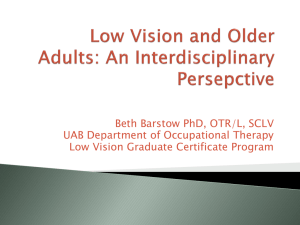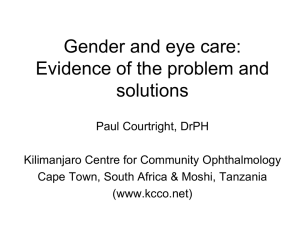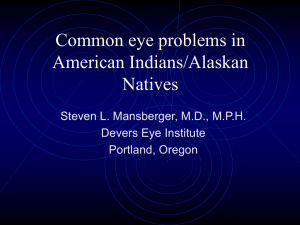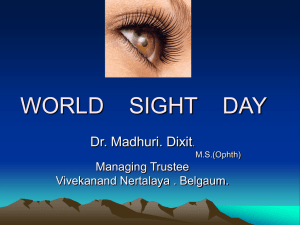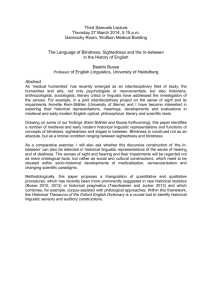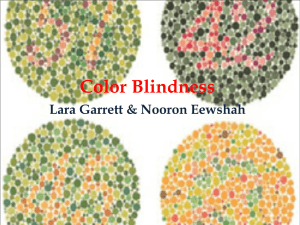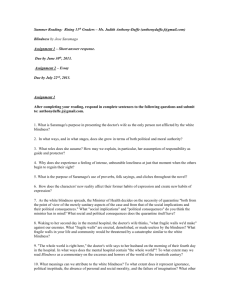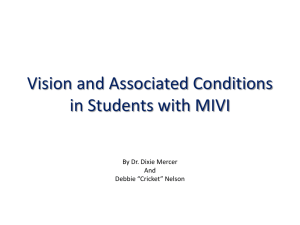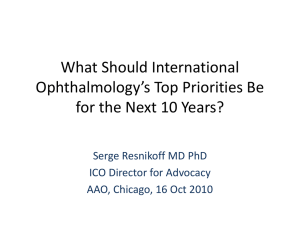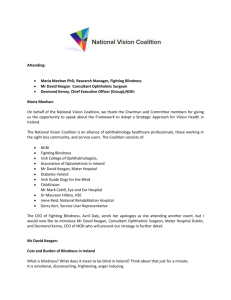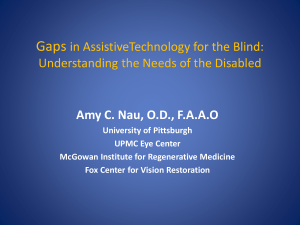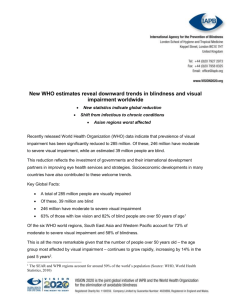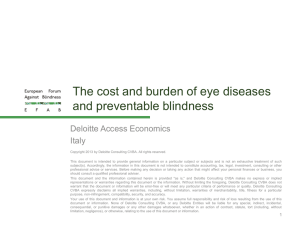Blindness 03.09.2013
advertisement
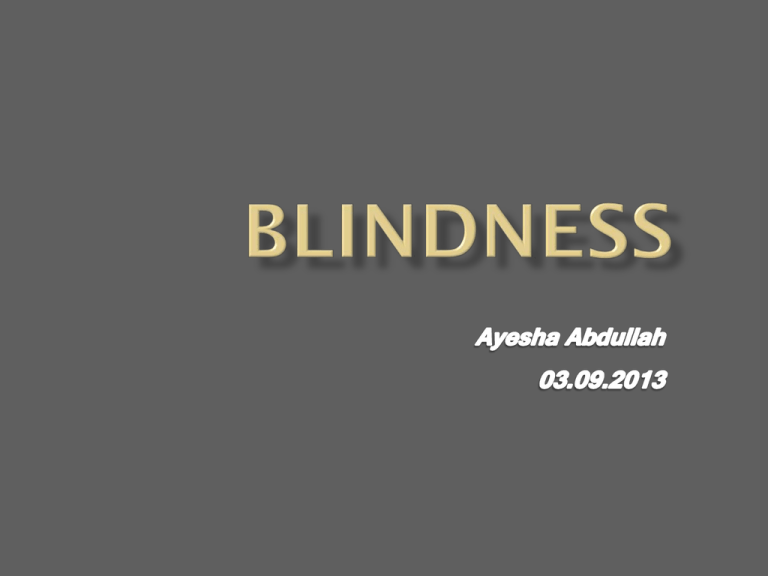
By the end of this lecture the students should be able to: Define blindness, visual impairment & low vision according to the WHO- ICD-10 classification Critically evaluate the definition & its implications Describe the global burden of blindness & visual impairment Identify the major causes of blindness at global and national level Recognize the impact of blindness on the life of the individual and the society Why should Ophthalmology be taught and learnt? 1. Approximately 314 million people suffer from serious visual impairment 2. 45 million people are blind and 124 million have low vision 3. 75% of blindness is avoidable - i.e. treatable and/or preventable 4. 90% of visually impaired people live in developing countries 5. Infectious causes of blindness are decreasing. Blinding trachoma now affects fewer than 80 million people, compared to 360 million in 1985 6. 153 million people’s visual impairment is due to uncorrected refractive errors. In most cases, normal vision could be restored with eyeglasses 7. Aging populations , lifestyle changes rising incidence of chronic blinding conditions such as diabetic retinopathy 8. Women face a greater risk of vision loss than men 9. Without effective, major intervention, the number of blind people worldwide is projected to increase to 76 million by 2020 10. Restorations of sight, and blindness prevention strategies are among the most cost-effective interventions in health care Why define? Blindness is defined in different ways in different countries according to the purpose of definition i.e legal, social, clinical etc WHO recommends the ICD-101 –based definition In Pakistan we use the same 1. International Statistical Classification of Diseases & related health problems, 10th revision (ICD-10) Chapter Blocks Title I A00-B99 Certain infectious and parasitic diseases II C00-D48 Neoplasms III D50-D89 Diseases of the blood and blood-forming organs and certain disorders involving the immune mechanism IV E00-E90 Endocrine, nutritional and metabolic diseases V F00-F99 Mental and behavioural disorders VI G00-G99 Diseases of the nervous system VII H00-H59 Diseases of the eye and adnexa VIII H60-H95 Diseases of the ear and mastoid process IX I00-I99 Diseases of the circulatory system X J00-J99 Diseases of the respiratory system XI K00-K93 Diseases of the digestive system XII L00-L99 Diseases of the skin and subcutaneous tissue XIII M00-M99 Diseases of the musculoskeletal system and connective tissue XIV N00-N99 Diseases of the genitourinary system XV O00-O99 Pregnancy, childbirth and the puerperium XVI P00-P96 Certain conditions originating in the perinatal period XVII Q00-Q99 Congenital malformations, deformations and chromosomal abnormalities XVIII R00-R99 Symptoms, signs and abnormal clinical and laboratory findings, not elsewhere classified XIX S00-T98 Injury, poisoning and certain other consequences of external causes XX V01-Y98 External causes of morbidity and mortality XXI Z00-Z99 Factors influencing health status and contact with health services XXII U00-U99 Codes for special purposes http://apps.who.int/classifications/icd10/browse/2010/en ICD VA VF (degrees) What it defines 0 6/6 – 6/18 > 20 Normal 1 <6/18-6/60 < 20 MVI 2 <6/60-3/60 3 <3/60-1/60 4 <1/60-PL B 5 NPL B Category SVI <10 B (ICD-10,Visual impairment (VI) categories 3, 4 & 5) Blindness is defined as a visual acuity (VA) of less than 3/60 (20/400) in the better eye with best possible correction Or A visual field in the better eye to less than 100 from fixation Key words? 6 visual acuity less than 3/60 5 4 3 2 1 6/12 in the better eye 1/60 1/60 Which one is the better eye? 2/60 best possible correction visual field loss Better eye less than 100 Organ Individual IndSociety Disease ——> Impairment ——> Disability ——> Handicap Organ system Damage Loss of performance Disadvantages to a person because of the impairment & disability VA 1 2 3 4 5 Rt eye (OD) 6/24 6/12 6/6 6/60 2/60 Visual Field Lt eye (OS) 2/60 6/9 1/60 PL 2/60 Rt eye (OD) Lt eye (OS) 150 100 Cause Number of blind in million % of total Cataract 25 50 Glaucoma 6.7 13.4 Refractive error 5 10 Trachoma 3 6 Vitamin A deficiency 0.5 1 Other causes of childhood blindness 1 2 Age-related macular degeneration 1 2 Onchocerciasis 0.4 0.8 Leprosy 0.3 0.6 Corneal opacity other than from Trachoma & other causes 7.1 14.2 DEVELOPED COUNTRIES DEVELOPING COUNTRIES Age-related macular degeneration (AMD) Cataract Diabetic retinopathy & glaucoma Glaucoma & corneal opacity Cataract Diabetic eye disease ( emerging) & AMD Blindness which could be either treated or prevented by known, cost-effective means Cataract Refractive errors Diabetic retinopathy Unavoidable blindness Retinal causes of childhood blindness ARMD ? Vitamin A deficiency Corneal xerosis Normal Keratomalacia Bitot spot DIABETIC RETINOPATHY A person has a visual acuity of 3/60 in the right eye and 6/60 in the left eye according to the WHO (ICD-10) classification he Has moderate visual impairment Is a blind person Is blind in the left eye Is blind in the right eye Is normal http://www.who.int/mediacentre/factsheets/fs282/e n/ (WHO website) http://www.v2020.org/page.asp?section=00010001 0002 ( Vision 2020 website) http://www.ncbi.nlm.nih.gov/pmc/articles/PMC2486 591/pdf/bullwho00405-0112.pdf http://www.who.int/classifications/apps/icd/icd10onli ne/ (ICD-10) http://www.who.int/blindness/Change%20the%20D efinition%20of%20Blindness.pdf Textbook Johnson GJ, Minassian DC, Weale RA, WestSk (editors). Prevalence, incidence and distribution of visual impairment. In The epidemiology of eye disease, 2nd Ed. London. Arnold 2003; 3-5


